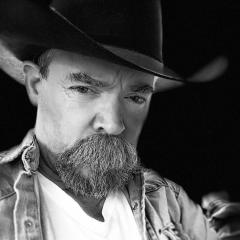-
Posts
4,393 -
Joined
-
Last visited
About bruce johnson
- Birthday 06/15/1960
Contact Methods
-
Website URL
http://www.brucejohnsonleather.com
Profile Information
-
Gender
Male
-
Location
Oakdale, CA
-
Interests
leather tools and history
LW Info
-
Leatherwork Specialty
Leather Tools
-
Interested in learning about
everything
-
How did you find leatherworker.net?
Ive been here from about day one
Recent Profile Visitors
58,738 profile views
bruce johnson's Achievements

Leatherworker.net Regular (4/4)
-
Mike, Thanks for catching that! Yes, 3/64 inch edger and I went back corrected that. Merry Christmas to you and yours!
-
The whole topic of edgers came up in an email yesterday. I made the reply that edgers could be an hour long topic in a class (easily). I did a thumbnail reply in another thread about types of edgers. Besides type, the other common question with edgers is "What size?" Here is my take. There are no standards for the number sizing for edgers between makers. One makers #2 may be different than another maker's #2. Even among a single maker the measured size/number may vary between styles of edgers. Historically the Gomph, HF Osborne, and vintage CS Osborne edgers were all 1/16 inch of cut per size number. For example the #1 was 1/16" of cut, the #3 was 3/16 inch of cut. Somewhere along the line, the sizes changed and a #3 now from a maker might be 3 mm, 1/16 inch, or some other measurement. The key is to know the maker edger style and then the actual cut measurement. What size of cut edger do you need? Everybody has a preference but here is mine. For most work like flat goods, belts, etc. I want my edger to have a cut width around 1/3 the thickness of the leather for edging top and bottom. For a 12 ounce piece (3/16 inch) I grab a 1/16 inch edger. For an 8 ounce piece (8/64") then I go with something like 3/64 inch of cut. These widths do two things - 1) they don't get into my stitch line on edges and 2) they round off the square edges and leave about half the edge of the piece square. By the time you rub that edge it will compress and shape some and that 1/2 thickness remaining square rounds over more. I like that look and feel for most work. If you want a heavier rounded edge for some applications (saddle horn or skirts) then choose an edger around half the thickness of the leather.
-
I just answered your email and came here to see this. I can expand a bit on what I didn't cover in my reply there. Straight edgers - generally flat bottom and cut a flat profile. I mostly sell them to makers of English horse tack. Round edgers - several styles that cut a rounded profile, concave bottom surface, some have a convex shape to the top edge and some are flat on top. usually a longer life with they are a blade style edger and easiest to maintain. My favorites. Cowboy edgers? - may be referring to Western edgers aka bent-toe edger - fairly easy to maintain, curved profile from the side. As they sharpen back the cutting edge goes back further and further around that corner and the angle you hold them at lowers. Bisonette edgers - hole in a flat blade and can theoretically cut on a push or pull stroke. How often do most people need to pull? Pretty rare. Harder to maintain and sharpen without widening the cutting edge. My wife likes them a lot. I sort of do but never saw any huge advantage. Finest edger, fine edger, Gomph Common edger - these have a V shaped fork in the tip. rounded profile, fairly easy to maintain, can trim linings close to a stitch line, sharp tips and are sometimes called "finger stabber edgers". Common edgers - lots of versions and several edgers get lumped as common edgers. Some of the vintage unmarked ones from Osborne were referred to as common edgers. rounded profile, easy to maintain, easy to widen out sharpening unless you are careful. Gomph called their "fine edgers" as "common edgers". French edgers - flat profile, can be used for edging, skiving edges, and if they have the right profile will gouge channels too. You asked in your email about tight inside curves - the turnback edgers will do that - short lifespan and tricky to sharpen. A round edger with short toes and narrow sides will do inside curves too.
-
I sell refurbished ones from a few makers and styles, and new ones from CS Osborne https://brucejohnsonleather.com/products/punching-tools/bagslot-punches
-
Have only see one or two in pictures before. Not very common.
-
white tape
-
I’ve done both. Straps loosely rolled in a jumbo zip lock. Flat pieces left flat. I left enough air to keep the plastic off the leather surface. Initial case in the morning or evening, 12 hours to even out, then tool. If I didn’t finish then back in the bag. I didn’t see much difference in the refrigerator or not.
-
That is how they are supposed to look. They are designed mainly for floral carving and especially beveling tight stem work with close lines. You can bevel a line without mashing down the adjacent cutc. Also to bevel a crossing element without mashing and leaving a large halo on the part below lie a flower over a stem or leaf. I liked steep bevelers for lightly breaking over the outside of a cut line for beadlines too. just lightly break that square edge.
-
And here I just make them out of old screwdrivers...you guys are fancy!
-
This right here. I am not picking on you but if I have to do anything more than once, every pass is a chance for error. It doesn't matter what. Two coats of dye on an edge, multiple hits on a stamp, whatever. Two or three passes with something with no steering like a wing divider - I am not that consistent either. Saddle divider with a wide flat inside surface to follow an edge then yes. Now the crabby old guy perspective and not pointed at anyone, just how i learned and was taught. I get this question a lot and here is my answer. The only place I did not groove was stitching into crease lines on wallet interiors with #69 thread. The purpose of a stitch groove is to recess the thread to prevent thread wear and/or add comfort to user in contact areas. They make different styles of groovers and different size grooving tips. You can match the groove width and depth to the thread size. even the amount of pressure you use can control depth and width with some groovers. You don't have to dig a 3x3 ditch for #92 thread and a scratch line for #346 is just a target line for straight stitching and not functional. For the people who say that you weaken the leather, I hear that a lot. The "strength of leather is all in the grain". OK, take that little spindle of leather you grooved off and pull it apart between a two finger grip. If that is the strength you need to keep your work together you have bigger problems. There is essentially no added strength in that little hair of leather. If there was then there would be instructions on how to make projects with it (actually you can make decorative miniature bird nests with it). The strength of the leather is all in the density of the dermis, thickness, and what part of the hide it comes from. That little sliver of epidermis is inconsequential. I have stickers made up (see below) on all the sewing machines in the shop for my wife and anyone who comes over and borrows some machine time.
-
Keep a straight stitch line and remember to watch the groover next time. I would rub out the errant groove line as best I could and regroove it before I stitch.
-

Steele Saddle Trees on Crates/Fabtron Saddles
bruce johnson replied to ellaecman's topic in Saddle Construction
The narrow bars just means that the bars are not as wide through the middle (waist) as other trees - theoretically for closer contact. We could get into a big discussion of whether that is true in real life, but that is another rabbit hole. The narrow bars should mean less contact surface and again - theoretically less weight bearing surface. The front and rear of the tree bear weight and the area overall is what controls pressure. A narrow waist on a tree is a minor factor fit. Bar angles, bar length, twist, rock in the bars, gullet/ handhole width, and relief at the bar edges are all bigger factors for fit than that narrow waist. -
Super nice clean work - tooling, stitching, and finish are all top notch1
-
Mine had the oval hole. I raised it all the way up when I was sewing wear leathers on saddle blankets. otherwise - the teeth barely clearing the slot.







